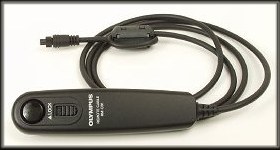


...or to to the C-5050Z, C-5060WZ, and C-7070WZ
...or to the Olympus E-10 and E-20 cameras
|
The RM-CB1 Cable Release for Olympus digital cameras |

|

|

|
My other articles related to the Olympus E-System...
...or to to the C-5050Z, C-5060WZ, and C-7070WZ ...or to the Olympus E-10 and E-20 cameras |
| Why a cable release? | |
|
When shooting from a tripod at non-handholdable shutter speeds, a cable release provides not only convenience, but also protection against camera shake. | |
|
The RM-CB1 cable release from Olympus is the only choice for many Olympus cameras, including the E-10/E-20, C-5060WZ/C-7070WZ, E-1, and E-300 (plus, most recently, the E-3), as these cameras use a proprietary connector supported by no other manufacturer. Proprietary connectors can be used for two reasons: (1) to provide technological advantages, or (2) to exclude any price competition and charge the captive audience whatever the manufacturer wishes. Here we are dealing, I suspect, with the second case. The release sells for about $60 in the US. |

|
|
Note: on the E-300, C-5060WZ, and C-7070WZ, the RM-CB1 will work with only when used with the optional battery holder/grip. This makes me quite unhappy. | |
|
Controls The release has one control: the shutter release button with the half-press capability, like the shutter release on the camera itself. It also has a slider to lock the "down" position, like the "T" setting on some cameras. Size The cable is almost four feet long. This is more than what we need operating the camera while being next to it, (two feet would be enough), but too short for a real remote operation (where ten feet would be useful). As it is, the extra length only gets into our way. The plastic part containing the controls is about 4 1/2 inches (11 cm) long: too large for my crowded gadget bag. Come on, there is just one button there! Why not half that size? Major gripes My main complaints are related not to the RM-CB1 itself, but rather to the proprietary connection between it and the camera. The camera's remote socket is protected with a tiny, plastic screw-on cap, with a 50/50 chance of jumping off your fingers when being removed, especially when you are outdoors. This is quite bad, and I can imagine hordes of photographers walking on all fours in the grass, and trying to find the little thing. It may look funny, but it isn't. The remote provides a screw-on holder for this cap, which looks good when you are reading about it, but is quite deeply recessed in the remote body. Screwing the cap on or off the remote, again, becomes a tricky operation, especially if your fingers are bigger than those of a four-year old. Leaving the remote socket cap off does not seem a good idea, as the wire connectors inside it seem quite vulnerable when the camera is stored in the bag. To make things worse, the cable plug has to be inserted in the proper orientation. The notch in the socket does not provide enough visual guidance to do it securely in field conditions. A concentric plug would be much better. Using the IR remote instead More often than not, I find myself too lazy to install the cable release for just one or two pictures, and instead I'm using the infrared remote held just above the camera, a little to the front. This is not as good (two-second time delay, no first-press exposure/focus preview), but requires less hassle. Too bad that for some unknown reasons the IR remote functionality is disabled when the LCD screen is on; another unnecessary inconvenience. The bottom line Now, do you need my advice whether to buy the RM-CB1? Well, if you really need a cable remote, then you don't have much choice; you have to buy it, warts and all. The owners of the C-5060WZ, C-7070WZ, and E-300 will have an extra decision to make: is the remote release worth buying an extra battery/holder at $100 or so? |

|

|

|
My other articles related to the Olympus E-System...
...or to to the C-5050Z, C-5060WZ, and C-7070WZ ...or to the Olympus E-10 and E-20 cameras |
| Home: wrotniak.net | Search this site | Change font size |
| Posted 2001/05/20; last updated 2008/02/04 | Copyright © 2001-2008 by J. Andrzej Wrotniak |